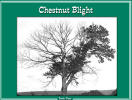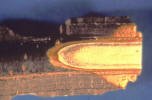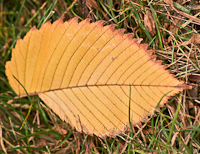|
 |
|
 |
|
Verticillium
Wilt - Oak
Wilt -
Dutch Elm Disease |
|
 |
 Wilting
is due to a deficiency of water in the foliage. Death
of the foliage and sometimes the shoots, large branches
or the whole plant may follow. Drought is not the only
cause of wilt. Root rots may deprive water to the upper
portion of the plant and cause a wilt. Fungal diseases
called "vascular wilts" clog the internal water
conducting tissues causing plants to wilt. Wilting
is due to a deficiency of water in the foliage. Death
of the foliage and sometimes the shoots, large branches
or the whole plant may follow. Drought is not the only
cause of wilt. Root rots may deprive water to the upper
portion of the plant and cause a wilt. Fungal diseases
called "vascular wilts" clog the internal water
conducting tissues causing plants to wilt.
To determine the cause of wilting, examine the soil moisture first.
Excessive water may cause root rots. Examine small roots for black discoloration.
Pull on a rotted root and the external skin will separate entirely from
the internal tissue. If the soil is adequately moist and the roots appear
normal, the problem may be a vascular wilt disease.
|
|
 |
 |
 Vascular
wilts cause wilting, withering and death to foliage
of trees. Cut diagonally into the wood of an affected branch and look
for sapwood discoloration in the growth ring. The discoloration is usually
dark green to brown and may be in streaks. Vascular
wilts cause wilting, withering and death to foliage
of trees. Cut diagonally into the wood of an affected branch and look
for sapwood discoloration in the growth ring. The discoloration is usually
dark green to brown and may be in streaks.
|
|
 |
 |
Several fungi cause wilt diseases. They act by plugging up the water and food
conducting vessels in the plant. Branches which are infected generally
die. Some plants die quickly while others may decline over years, losing
major branches one at a time.
The discolored sapwood is the result of wound
gums and chemicals formed by the plant in an attempt to stop the fungal
infection. A vigorous plant can sometimes lock up the fungal infection
in the annual growth ring of wood, then form an uninfected ring of sapwood
during the following year's growth.
Maple and
Russian olive trees in vigorous
health often escape verticillium wilt in this manner. Stressed trees will
lose major branches or die outright.
|
 |
|
Verticillium Wilt
Verticillium is a soil borne fungus that infects the roots of a tree
or shrub but does not cause a root rot. Instead, the fungus moves into
the water conducting tissues of the plant. It may affect all or only sections
of a tree depending on how it is introduced into the plant.
Control: One major control is to avoid damaging
the root system of trees and shrubs. Although the infection may come directly
from the nursery, it may also be introduced later through wounds in the
root system. When the plant is infected, cut off dead branches and limbs
and dispose of them. Do not use this wood for chips or
compost and do not
bury it near other susceptible plants. Burning is the best option.
 |
 |
|
Oak
Wilt
Wilt, defoliation and the premature drop of leaves help distinguish
vascular wilt from other causes of wilting.
Cause: Oak wilt is caused by a fungus sap feeding beetles and other insects
that are attracted to wounds on the bark of trees. Infected red oaks may
die within a few weeks while white oaks may linger for two or three years.
In the mid-west, it appears that the infection is most likely to occur
in mid-May to June. Therefore, it is important to avoid pruning, climbing
with iron shoes or otherwise wounding oaks during this time. The disease
may spread to adjacent oaks through root grafts.
Control: Infected trees should be removed and wood, including stumps, should
be debarked and split. Otherwise the wood will bloom with fungus beneath
the bark and insects will carry them onto other trees. Closely planted
trees should be treated to remove the chances of root grafting. This may
be done by passing a root cutting blade 2 feet into the ground at the midpoint
between the trees.
 |
 |
|
Dutch Elm Disease
 Dutch elm disease is a fungal vascular disease responsible for killing
most American elm (Ulmus
americana) trees in the
United States. The disease was introduced
on wood from Holland (thus the name) and spread rapidly across the country.
Siberian (Ulmus
pumila), Chinese (Ulmus
parvifolia) and certain hybrid elms are resistant to the disease. Dutch elm disease is a fungal vascular disease responsible for killing
most American elm (Ulmus
americana) trees in the
United States. The disease was introduced
on wood from Holland (thus the name) and spread rapidly across the country.
Siberian (Ulmus
pumila), Chinese (Ulmus
parvifolia) and certain hybrid elms are resistant to the disease.
Symptoms: Wilting, yellowing foliage and leaf drop first occur on one or a few
branches. Then the entire tree may wilt and die in a few months to a few
years.
Cause:
Bark beetles that feed in the branch crotches of elm trees and burrow
tunnels and lay eggs in dying or dead elm wood carry the fungus that causes
the vascular wilt disease. Beetles generally are attracted to stressed
trees rather than healthy trees. Controlling the beetles may help control
the disease. Quickly destroying dead elm wood and dying trees and keeping
healthy trees vigorous helps to limit the spread of the disease.
Control:
Prune out infected branches immediately. When pruning, cut well below
the area showing symptoms - at least 6 inches below the brown vascular
discoloration on the wilted branch. The pathogen is usually a distance
beyond the symptoms. Closely planted trees should be treated to remove
the chances of root grafting. This may be done by passing a root cutting
blade 2 feet into the soil at the midpoint between the trees. Systemic
insecticides and
fungicides have been tested but do not appear to be fully
effective in the control of Dutch elm disease.
 |
|
 |
|
Note: We
have provided some general information and
observations on this topic aimed at the home
gardener. Before you take
any serious action in your landscape, check
with your state's land grant university's
Cooperative
Extension
Service for the most current,
appropriate, localized recommendations. |
|



